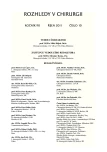Secondary Peritonitis Prognosis Assessment
Authors:
P. Novák; V. Liška; T. Kural; M. Brabec; J. Kulda; V. Třeška
Authors‘ workplace:
Chirurgická klinika LF UK a FN v Plzni, přednosta: prof. MUDr. Vladislav Třeška, DrSc.
Published in:
Rozhl. Chir., 2011, roč. 90, č. 10, s. 543-548.
Category:
Monothematic special - Original
Overview
Introduction:
Secondary peritonitis is a severe disease with high mortality and morbidity. In the last 20 years the results of treatment of this disease have improved markedly.
Aim of the study:
To determine statistically significant risk factors for mortality in patients with severe secondary peritonitis.
Material and methods:
We studied in retrospective analysis the cohort of patients treated at our clinic in the period 2005–2010. 65 patients (38 men and 27 women) with an average age of 60.7 years were included. 27 patients died (41.5%). The average age of the died patients was 72 years. The average value of APACHE II was 20.77, which corresponds to the prediction of lethality 41.8%. The average value of the SOFA score was 11.87.
Results:
The performed statistical analysis showed age over 65 years, bronchopneumonia, obesity, ischemic heart disease, artificial ventilation over 6 days and circulatory support over 10 days as statistically significant independent factors for mortality. Patients older than 65 years had 8.9 times greater risk of death. In the case of bronchopneumonia was the risk 4.8 times higher. Obesity increased the risk of death 3.1 times and ischemic heart disease 2.4 times. In the case of mechanical ventilation for more than 6 days and circulatory support for more than 10 days, these increased the risk of death 4.1 times respectively 4.3 times.
Discussion:
The benefit for determining the prognosis secondary peritonitis is the use of scoring systems. It was also shown that the basic clinical data may have the same benefit for predicting the prognosis of patients as a sophisticated scoring systems.
Conclusion:
The performed retrospective analysis age over 65 years, bronchopneumonia, obesity, artificial ventilation and circulatory support as statistically significant independent factors for prediction of poor survival. These basic clinical factors correlated with scoring systems APACHE II a SOFA.
Key words:
severe secondary peritonitis – surgical treatment – scoring systems – prediction of survival
Sources
1. Opmeer, B. C., Boer, K. R., van Rulet, O., Reitsma, J. B., et al. Costs of relaparotomy on-demand versus planned relaparotomy in patiens with severe peritonitis: an economic evaluation within a randomized controlled trial. Critical Care, 2010, 14: R97.
2. Koperna, T., Schulz, F. Relaparotomy in peritonitis: Prognosis and treatment of patiens with persisting intraabdominal infection. World J. Surg., 2000, 24, 32–37.
3. Lamme, B., Boermeerester, A., Reitsma, B., Wahler, W., et al. Meta-analysis of relaparotomy for secondary peritonitis. British Journal of Surgery, 2002, 89, 1516–1524.
4. Herzog, T., Chromik, A. M., Uhl, W. Treatment of complicated intra-abdominal infections in the era of multi-drug resistant bakteria. Eur. J. Med. Res., 2010, Nov 30, 15(12): 525–532.
5. Vyhnánek, F. Antimikrobiální léčba u komplikované nitrobřišní infekce – současný stav. Rozhl. Chir., 2009, roč. 88, č. 4, s. 206–213.
6. Pieracci, F. M., Barie, P. S. Intra-abdominal infections. Curr. Opin. Crit. Care, 2007, Aug. 13(4), 440–449.
7. Vyhnánek, F. Urgentní nitrobřišní operace v sepsi. Medical Tribune, 20/2008.
8. Robledo, F. A., Luque-de-León, E., Suárez, R., Sánchez, P., et al. Open versus closed management of the abdomen in the surgical treatmant of severe secondary peritonitis: randomized clinical trial. Surg. Infect, 2007, Feb, 8(1): 63–72.
9. Oetting, P., Rau, B., Schlag, P. M. Abdominal vakuum device with open abdomen. Chirurg, 2006 Jul: 77(7): 586, 588–593.
10. Fieger, A. J., Schwatlo, F., Mandel, D. F., Schenk, M., Hemminger, F., et al. Abdominal vakuum therapy for the open abdomen – a retrospective analysis of 82 consecutive patiens. Zentralbl. Chir., 2011 Feb: 136(1): 56–60, Roub 2011 Feb 18.
11: Caro, A., Olona, C., Jiménez, A., Vadillo, J., Feliu, F., Vicente, V. Treatment of the open abdomen with topival negative pressure therapy: a retrospective study of 46 cases
12. Ordoňez, C. A., Puyana, J. C. Management of peritonitis in the critically ill patient. Surg. Clin. North Am., 2006 Dec: 86(6): 1323–1349.
13. van Goor, H. Interventional management of abdominal sepsis: when and how. Langenbeck‘s Arch. Surg., (2002) 387 : 191–200.
14. Beger, H. G., Buechler, M., Bittner, R., et al. Necrosectomy and postoperative local lavage in necrotizing pankreatitis Br. J. Surg., 1988, 75 : 207–212.
15. Oddeke, R., Mahler, C. W., Boer, K. B., Reuland, E. A., at al. Comparison of on demand vs planned relaparotomy strategy in patiens with severe peritonitis. Jama, Aug 22/29, 2007, Vol. 298, No. 8.
16. Schein, M. Surgical management of intra-abdominal infection: is there any evidence? Langenbeck‘s Arch. Surg., (2002) 387 : 1–7.
17. Mandell, K., Arbabi, S. Re-laparotomy for severe intra-abdominal infections Surg. Infect, 2010 Jun: 11(3): 307–310.
Labels
Surgery Orthopaedics Trauma surgeryArticle was published in
Perspectives in Surgery

2011 Issue 10
- Metamizole at a Glance and in Practice – Effective Non-Opioid Analgesic for All Ages
- Possibilities of Using Metamizole in the Treatment of Acute Primary Headaches
- Metamizole in perioperative treatment in children under 14 years – results of a questionnaire survey from practice
Most read in this issue
- Gall Bladder Adenomyomatosis
- Acute Appendicitis – Overview of Current Knowledge
- Clinical Outcomes of Surgical Management of Acromioclavicular Dislocation with and without Ligament Suturing
- Surgical Management of Jejunal Diverticulosis Complications
